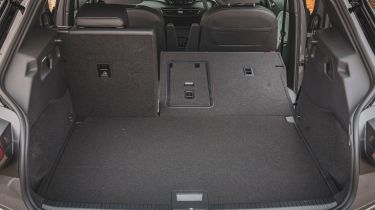Volkswagen ID.3 review: boot space, seating & practicality
The Volkswagen ID.3 has enough room for a family and their luggage, but it's not the most spacious electric car of its type
| Length | Width | Height | Boot volume (seats up/down) |
|---|---|---|---|
| 4,261mm | 1,809mm | 1,568mm | 385/1,267 litres |
Even though it’s roughly the same size as a Golf, the Volkswagen ID.3 is more spacious inside. That’s because it was designed as an electric car from the start, and the motor and batteries are more flexible in terms of where they can be placed than a combustion engine.
The relatively sparse interior with few buttons means that there’s an airy feeling to the cabin in the front, and the seats are comfortable, too – especially if you go for the electrically-operated ergoComfort seats on the range-topping Pro S car, complete with adjustable lumbar support.
Further to this, the light steering and effortless acceleration mean fatigue shouldn’t be an issue on long drives.
Volkswagen ID.3 interior space, storage & comfort
The ID.3 has lots of room for passengers in the back seats, as there’s enough leg and headroom for adults. There are three seats in the back of entry-level Pro cars, but the bigger battery on Pro S models means these cars only have room for two in the rear. We ran a pre-facelift car for six months through 2021-22 and found this particularly annoying at times.
Regardless of which you go for, there’s no hump in the floor in the middle so there’s plenty of space for feet, and kneeroom is adequate, too. Only the very tallest adults should struggle for headroom, but those regularly carrying passengers are probably better served by the larger ID.4 anyway.
There are lots of storage options in the cabin, too, with places for your phone, cupholders and decent door bins for other odds and ends.
In March 2021, Volkswagen announced a range of dealer-fit accessories for the ID.3, including an assortment of protection packs, (available with either carpet or rubber floor mats), door mirror caps and a bicycle carrier. The carrier attaches to the car’s transport hitch and is compatible with all ID.3 models except the 77kWh battery Pro S version.
Boot space
The ID.3’s boot holds 385 litres with the rear seats in place, which is only a tiny bit more than you get in a Volkswagen Golf. That’s a shame, but at least there’s plenty of room for passengers. It’s smaller than a Nissan Leaf back there, as the Japanese hatchback has 420 litres of boot space, while the Kia Niro EV offers a whopping 475 litres of cargo space.
Folding the seats down opens up 1,267 litres of luggage space, but the seats don’t fold completely flat. This means there’s a significant lump in the floor that you have to heft longer items over when sliding them in. Still, this is even more of an issue in the Leaf, despite that car having more space with the rear seats up. The Nissan also has less room in total than the Volkswagen.

